|
Monday 28th August
to Sunday 3rd September 2023 |
| |
|
Thursday 31st August sees the second Full
Moon of the month. When this occurs, the second one is commonly called a
Blue Moon, but this is technically incorrect. The mis-interpretation of the
definition first appeared in print back in 1946 and it stuck because it is
easier to understand. Officially, a Blue Moon is the third full moon in a
season of four. Let's just stay with the first definition! |
| |
|
This Full Moon occurs at perigee again, when
the Moon is closest to the Earth in its orbit around us and looks slightly
brighter and larger than at other times, so it is therefore called a Super
Blue Moon. |
| |
|
On 31st, just as it's getting dark, the Moon
will have risen above the horizon towards the east, with Saturn shining to
the right of it and a little higher in the sky. |
| |
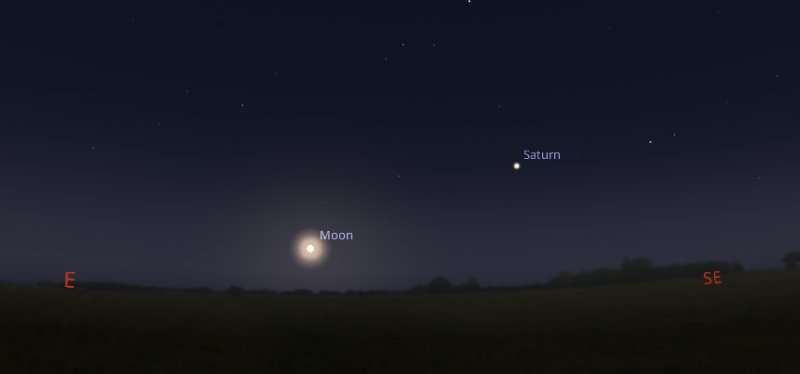 |
| |
|
If you stay up to around 11pm, then the Moon
will appear more towards the south east and Jupiter will have risen to the
left of it in the east. |
| |
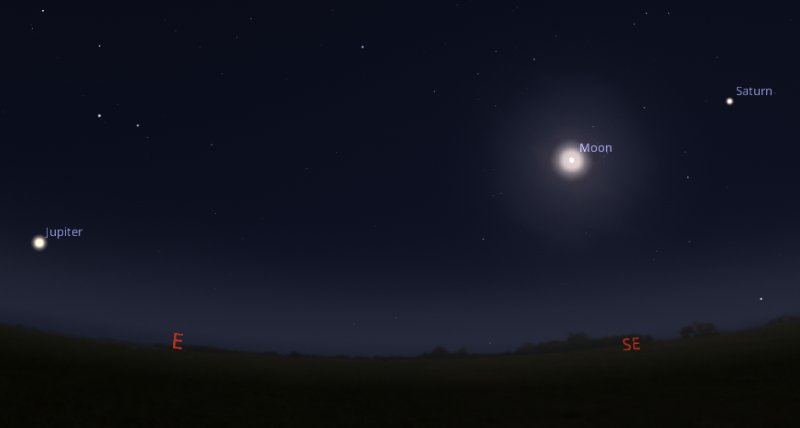 |
| |
|
Ironically, full moons at this time of year tend to be at a relatively low
altitude so they appear more orange than blue! The light being reflected
from the Moon's
surface passes through more of our atmosphere and this scatters the blue
wavelengths. If you catch the Moon rising above the horizon, it sometimes
looks huge. This is known as "Moon Illusion" and is simply a trick that
your brain plays on you - although the effect has been known about for
thousands of years, we still don't understand why! It has nothing to do
with the Moon being at perigee. |
| |
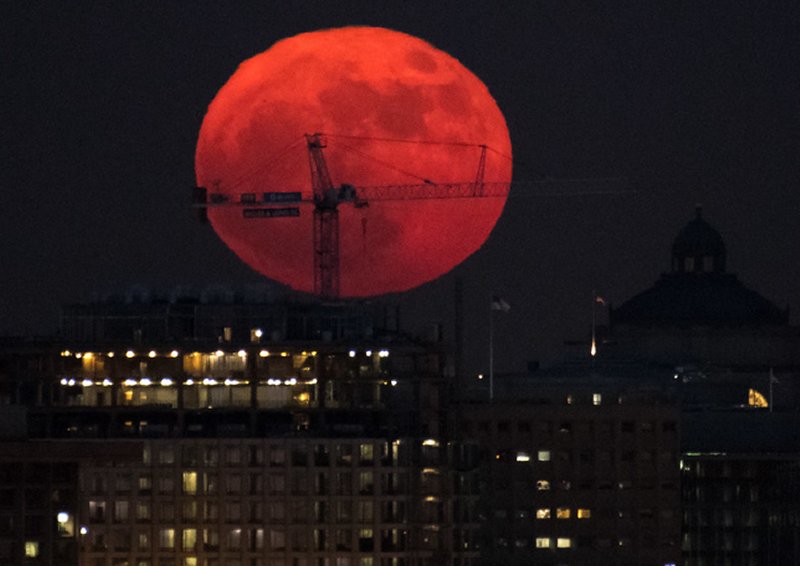 |
| |
|
Moon Illusion image courtesy of
NASA |
|
Monday 21st
to Sunday 27th August 2023 |
| |
|
Last week I talked about the astronomical
term "conjunction" where two celestial objects appear to be close together.
Another term called "opposition" occurs when two bodies are in opposite
parts of the sky. |
| |
|
On Sunday 27th, Saturn reaches opposition to
the Sun, so it is well-placed for observing with a magnitude of around +0.3
and the planet reaches a maximum elevation of 25 degrees above the horizon. |
| |
|
If you venture outside any evening next week
and look towards the south around midnight, Saturn will be approaching this
maximum height in the sky. |
| |
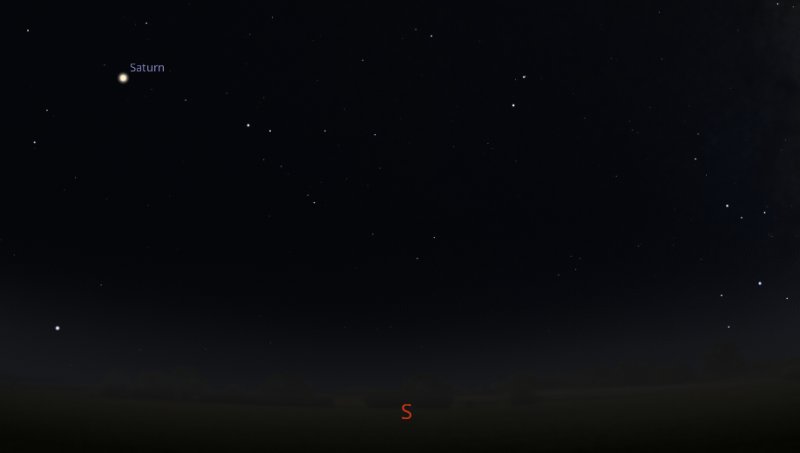 |
| |
|
As light passes through our atmosphere, it
becomes distorted which can spoil the view through a telescope with high
magnification eyepieces and it is also why stars appear to twinkle.
Astronomers always prefer to observe objects when they are at high
elevations and the light from them is passing through less atmosphere, so
next week is an ideal opportunity to point your telescope towards Saturn and
look at those amazing rings circling around it! |
| |
|
The rings are made from countless particles
ranging in size from a few micro-meters to several meters in diameter. They
are mainly made from water ice and to this day, space scientists cannot
agree how they were originally formed. |
| |
|
The first person to observe them was Galileo
back in 1610, but with his basic telescope, he was unable to resolve any
detail. A much better view was provided by the Voyager 2 space probe in
1981. |
| |
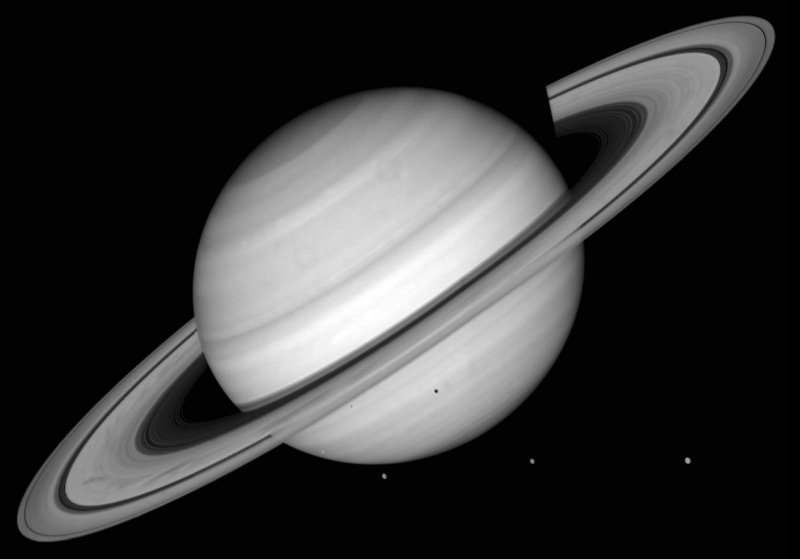 |
| |
|
Image courtesy of NASA |
|
Monday 14th
to Sunday 20th August 2023 |
| |
|
Mercury and Venus are "inferior planets".
Now that sounds like I'm being a bit nasty, but in astronomical terms it's
nothing derogatory at all. It simply means that those planets orbit around
the Sun inside our own orbit or in other words, they are closer to the Sun
than us and we are classed as the "superior planet". |
| |
|
To a Martian, Mars would be the superior
planet and the Earth would be classed as another inferior planet! |
| |
|
At the beginning of next week, Venus will
have just passed an "inferior conjunction" with the Sun. An astronomical
conjunction occurs when two objects appear close together, but of course
this is only from the observer's perspective which is two dimensional as you
have no depth perception when looking at something in the distance - in
reality the objects will still be far away from each other when you think
three dimensionally. |
| |
|
An inferior conjunction takes place when the
inferior planet is in a straight line directly between the superior planet
and the Sun. |
| |
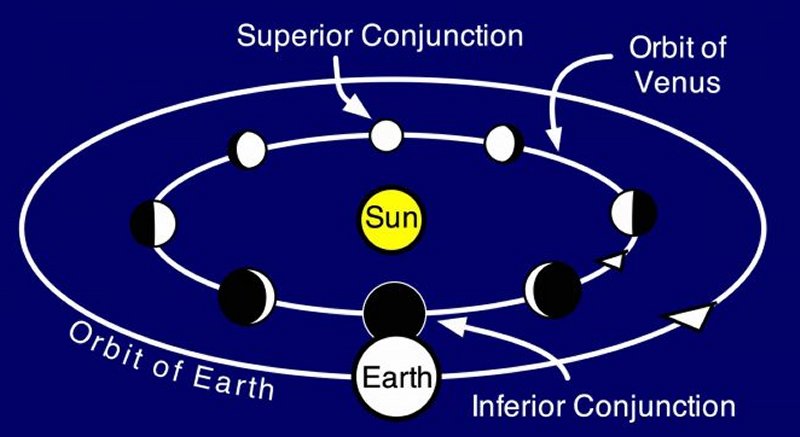 |
| |
|
Conjunction diagram courtesy of
EarthSky.org |
| |
|
As they orbit around the Sun, inferior
planets also show different phases, just like our own Moon. If you were to
try observing Venus at its inferior conjunction, you would see a thin phase
of 0.1%, like a very, very thin crescent, but please don't be tempted to try
it as you would be looking directly towards the Sun and this would cause
instant and permanent blindness. The experiment would need very specialised
equipment and a camera rather than an eyepiece! |
|
Monday 7th
to Sunday 13th August 2023 |
| |
|
It's worth staying up to around 2am on the
early morning of Wednesday 9th as there will be a nice treat for the naked
eye - no telescope necessary. Look towards the east and you will see three
targets - running left to right - the Pleiades open cluster of stars, a
waning Crescent Moon and Jupiter. |
| |
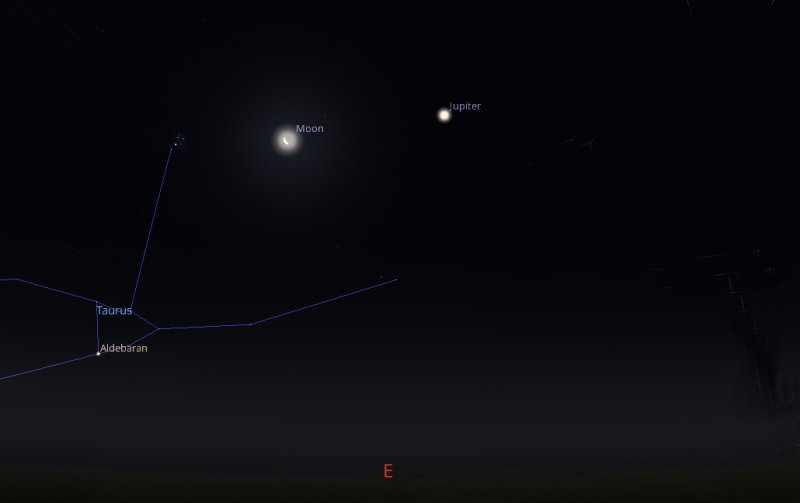 |
| |
|
The Pleiades is at the top of the
constellation of Taurus. If you really feel the urge to dig out your
telescope, aim it that direction and locate the bright star Aldebaran in
Taurus. To the right of Aldebaran will be the Hyades open cluster. |
| |
|
If you'd prefer an activity earlier in the
evening, look high up towards the south east after dark anytime next week
and find the constellation of Cygnus, the "Swan". Below the tail of Cygnus
will be two small constellations called Vulpecula and Sagitta. When lines
are drawn to show the shapes of constellations, Vulpecula looks like a
straight line and Sagitta looks like an arrow. |
| |
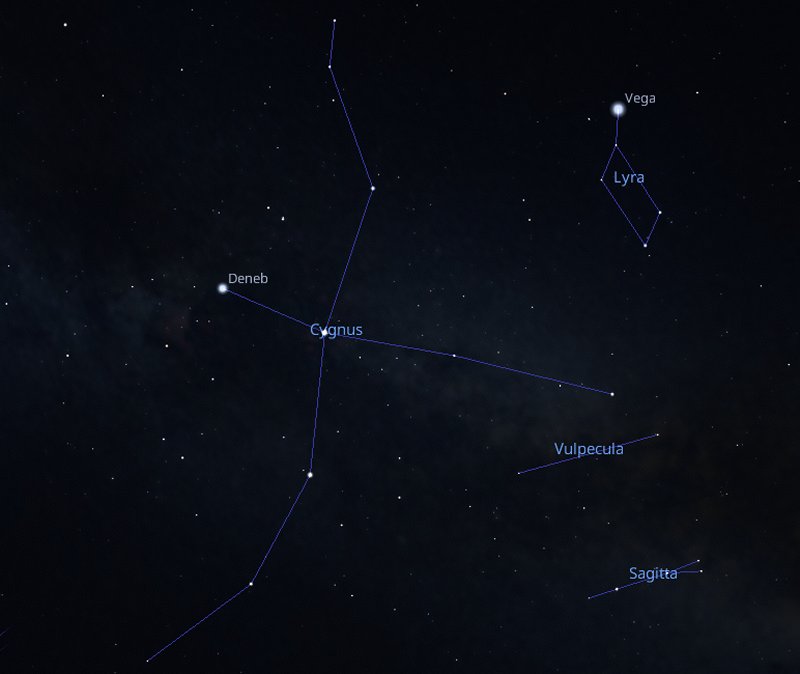 |
| |
|
My reason for sending you towards these two
unremarkable constellations is that between them you will find an asterism
or recognisable pattern of stars known as the "Coat Hanger". It will take a
bit of looking for and will actually appear to be upside down. |
| |
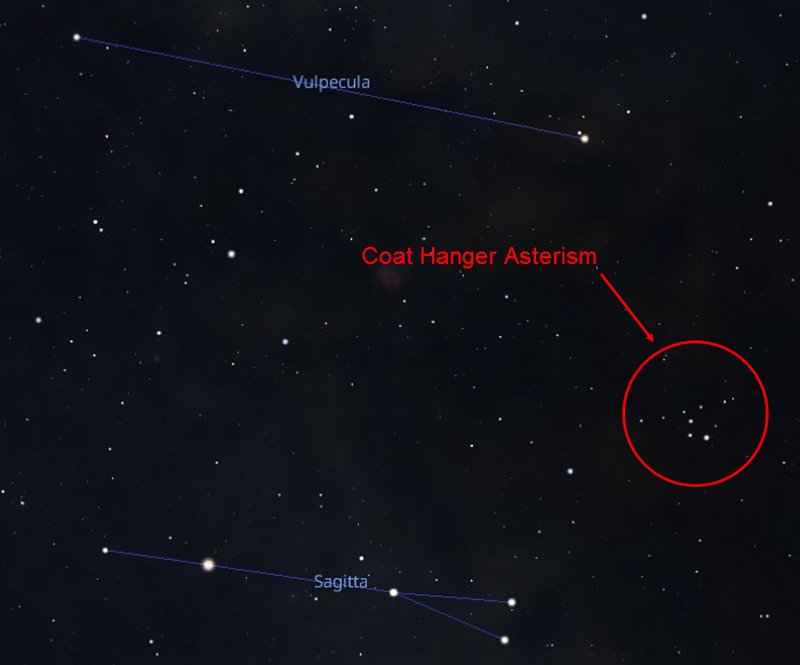 |
| |
|
The asterism consists of ten main stars and
is officially known as "Brocchi's Cluster". This is a bit of a misnomer
though, as the stars are not thought to be gravitationally tied to each
other, so technically they are not a cluster! With the naked eye, the
asterism will only look like a faint patch of light - binoculars or a small
telescope will be needed to resolve the detail. Just need some clear sky to
be able to do it! |
|
Monday 31st July
to Sunday 6th August 2023 |
| |
|
On the evening of Tuesday 1st August, we have
a Full Moon. At 10pm, our celestial neighbour will have just risen above
the horizon towards the south east. |
| |
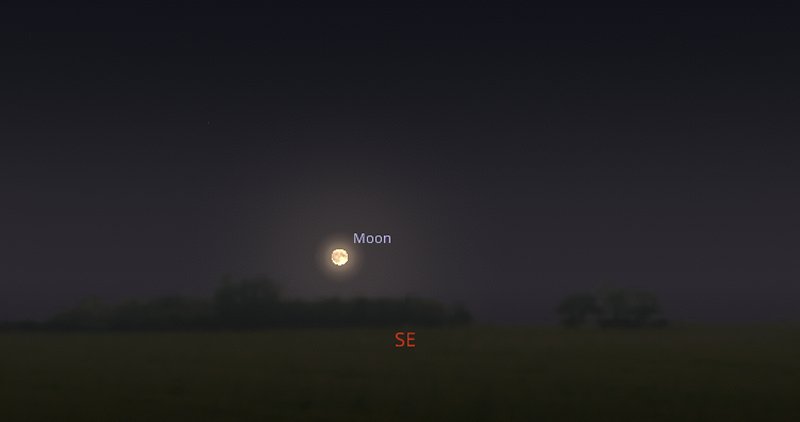 |
| |
|
Nothing out there in space is a perfect
circle and the Moon's orbit around us every 27 days is slightly elliptical
or "egg shaped". The point where the Moon gets closest to us is known as
"Perigee" and at that time it is about 225,000 miles away. The opposite
point, when the Moon is furthest from us is called "Apogee" and then the
Moon is about 251,000 miles from us. |
| |
|
The Full Moon on 1st happens to occur very
close to perigee which means that it will appear to be 14% larger and 25%
brighter than a Full Moon at apogee. This is referred to as being a
"Supermoon". August is also unusual in that there will be two full moons in
the same month, with another on 31st August. |
| |
|
Now I was never that good at maths, but if
the Moon takes 27 days to orbit around us, why is it a few days longer than
that between the full moons? |
| |
|
While the Moon has been orbiting around us,
we have been travelling in our orbit around the Sun, so all the angles will
have changed and the Moon will need to travel a bit further before the
sunlight falling on it fully illuminates the near side again.
|
| |
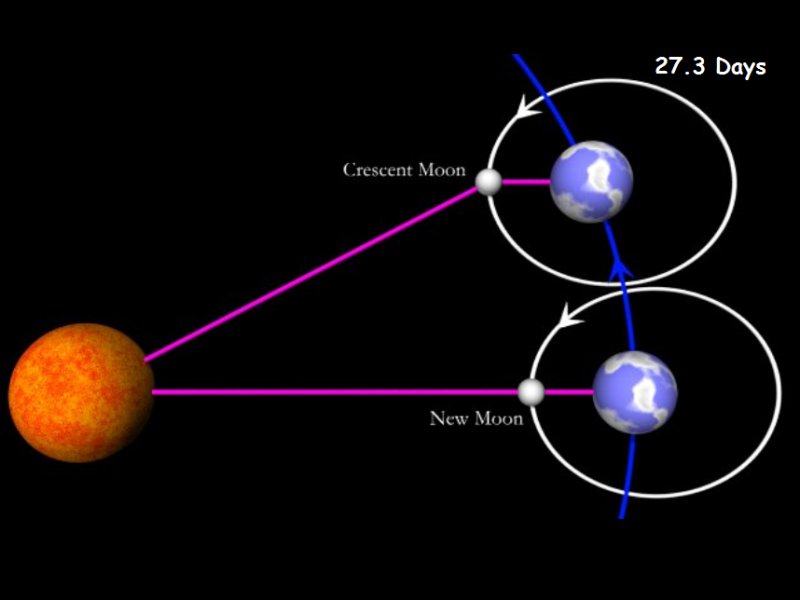 |
| |
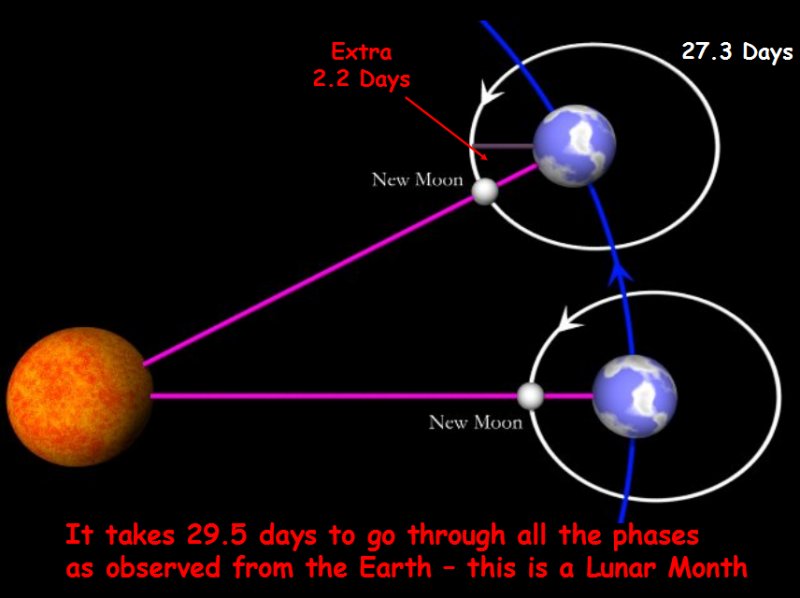 |
|
Monday 24th to
Sunday 30th July 2023 |
| |
|
If you venture outside around 2am any day
next week and look towards the east, Jupiter will have risen above the
horizon. To the left of Jupiter you will find the familiar shape of the
Pleiades open cluster of stars. |
| |
|
Half way between the two is Uranus - not a
planet you can see with the naked eye as it currently has a magnitude of
around +6.0 so you'll need to dig out those binoculars or a small
telescope. |
| |
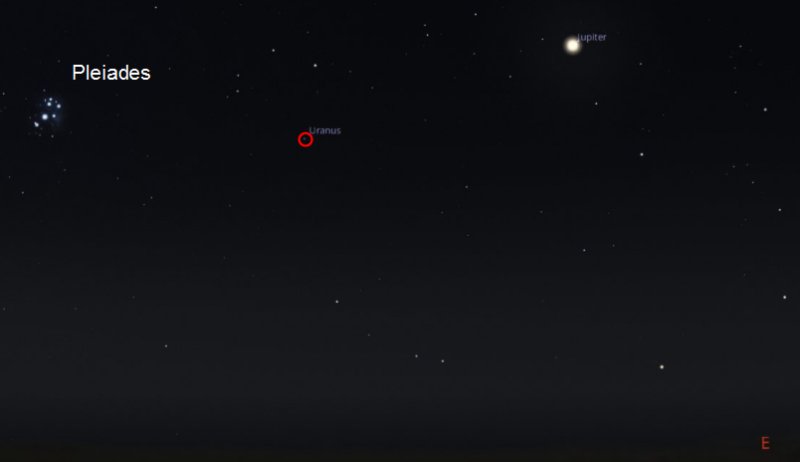 |
| |
|
For those of you preferring not to stay up
quite so late, try looking towards the south west around 11pm on Thursday
27th and you will see a slightly gibbous-shaped Moon. |
| |
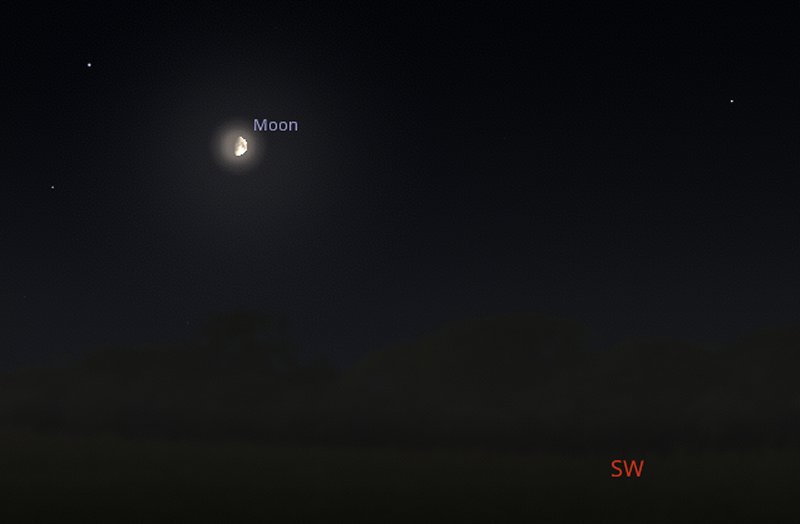 |
| |
|
The 27th is the optimum evening to spot the
clair-obscur effect that I've mentioned before, known as the Jewelled
Handle. It appears as an arc of light near the northern sunlight
terminator. |
| |
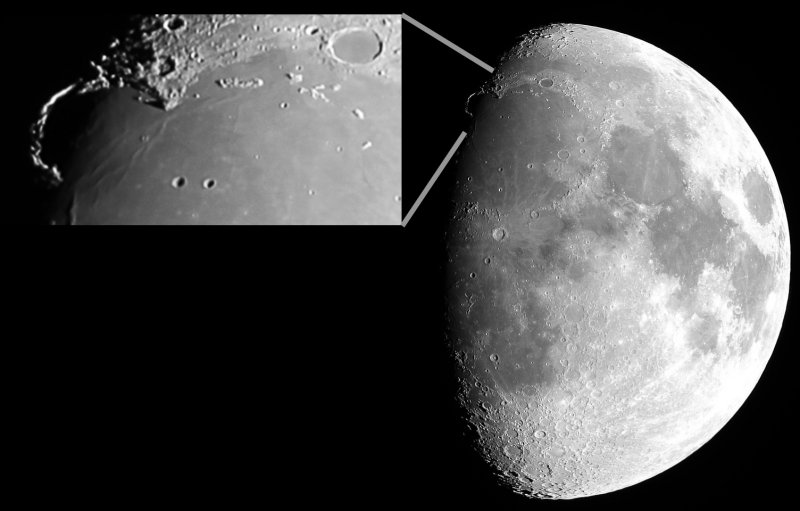 |
| |
|
At the same time, look to the left of the
Moon and have a go at spotting the red supergiant star Antares.
|
| |
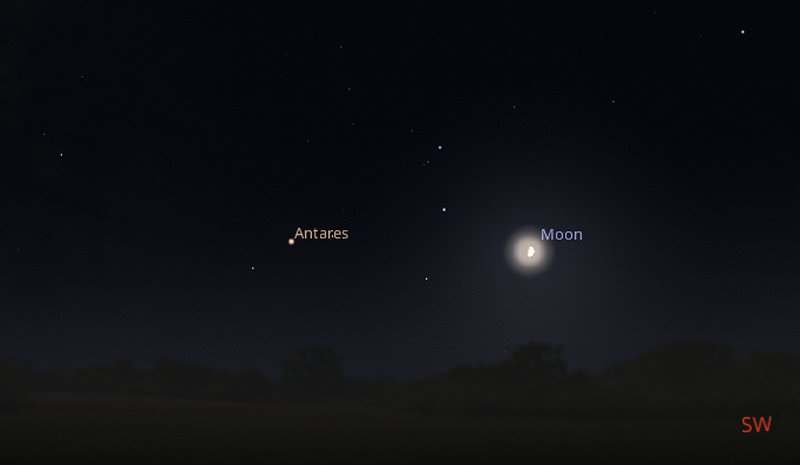 |
| |
|
With a magnitude of around +1.0 it is one of
the brightest stars in the night sky and one of the largest stars that can
be seen with the naked eye. Its mass is about twelve times that of our
Sun. If we stuck Antares in the middle of our Solar System, it would
stretch out as far as Jupiter and consume all the rocky planets of our Inner
Solar System! |
| |
|
Antares is actually a binary star - you will
only see the red supergiant, but there is also a smaller, magnitude +5.5
dwarf star beside it. |
|
Monday 17th to
Sunday 23rd July 2023 |
| |
|
It's time to go hunting for a minor planet in
the Asteroid Belt. |
| |
|
Last week I suggested looking towards the
east to see Jupiter and the bright star Capella. Look east again at around
3am on Tuesday 18th and you will have a similar view, with the Pleiades open
cluster of stars sitting about half way between Jupiter and Capella. Down
from the Pleiades and quite close to the horizon will be the bright star
Aldebaran. |
| |
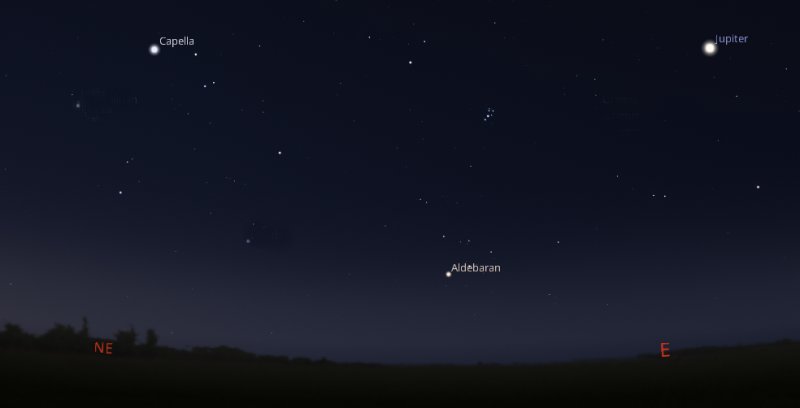 |
| |
|
Our target, the minor planet (4) Vesta is
hiding a little above and to the left of Aldebaran. It will only have a
magnitude of around +8.3 so you will definitely need a small telescope to be
able to spot it. |
| |
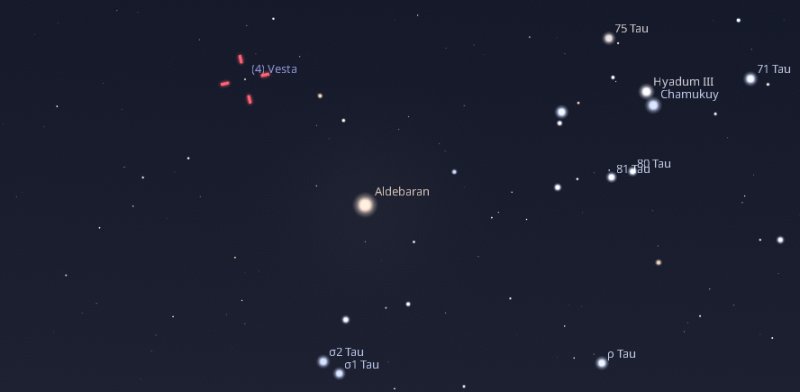 |
| |
|
(4) Vesta is the second-largest minor planet
in the Asteroid Belt (second only to Ceres) with a mean diameter of 525Km.
It is also the brightest object in the belt. The asteroid is rocky and made
from the same materials that formed the planets of the inner Solar System
billions of years ago, but how do we know this? |
| |
|
Vesta is covered in impact craters. Around 1
- 2 billion years ago, numerous fragments were ejected after several
collisions and some of this debris made its way to Earth, landing as
meteorites for scientists to subsequently study. |
| |
|
Interest is this little rocky fella has been
so great that the NASA Dawn spacecraft spent a year orbiting around it in
2011 before continuing its main mission towards Ceres. |
| |
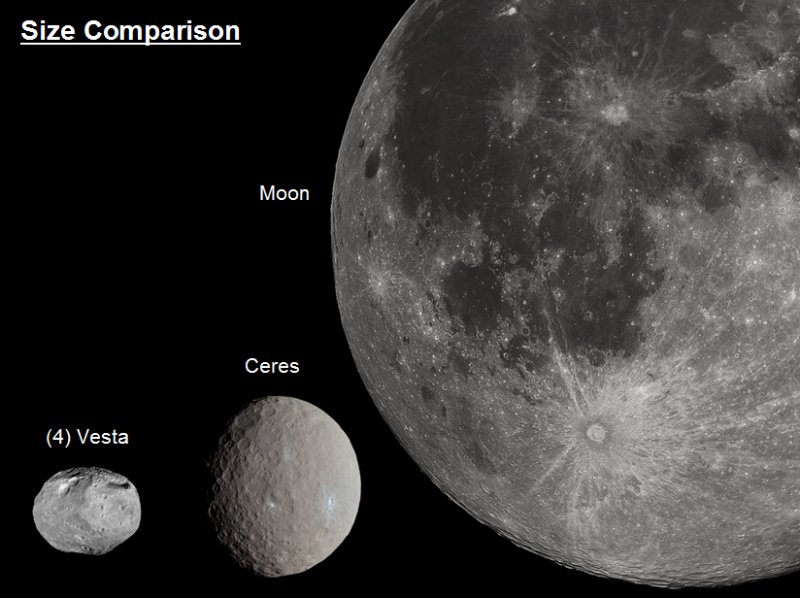 |
|
Monday 10th to
Sunday 16th July 2023 |
| |
|
If you look towards the east early in the
morning on Wednesday 12th, say around 1.30am, a 29%-lit Crescent Moon will
have just risen above the horizon, with planet Jupiter immediately to the
right of it shining at a magnitude of -2.1 |
| |
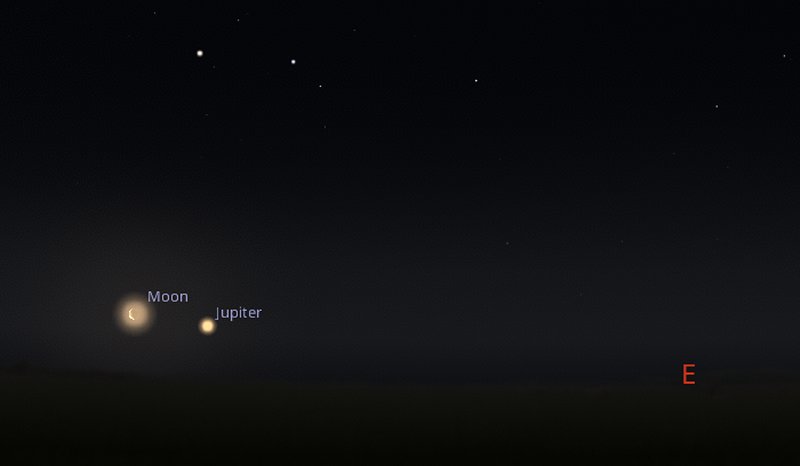 |
| |
|
Taking in a wider view, Saturn will be
located towards the south east and the bright star Capella will be towards
the north east. |
| |
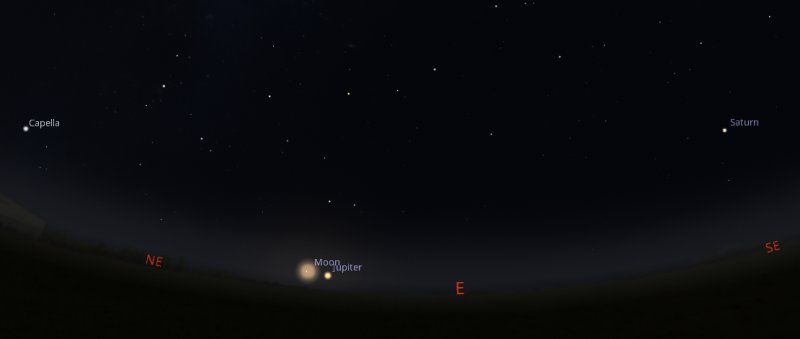 |
| |
|
Capella is actually the sixth brightest star
in the night sky and the alpha star in the constellation of Auriga.
Although it appears to be a single star to the naked eye, Capella is a
quadruple star system comprising two bright yellow giant stars that are
about two and a half times the size of our Sun and two much fainter red
dwarf stars. The stars are relatively close to us - around 43 light years
away. |
| |
|
If you want to see the whole of Auriga, you
will have to wait until around 3am when all its stars will have all risen
above the horizon. Immediately to the right of Auriga and very close to the
horizon will be the constellation of Taurus, with the easily-identifiable
Pleiades open cluster of stars just above Taurus. |
| |
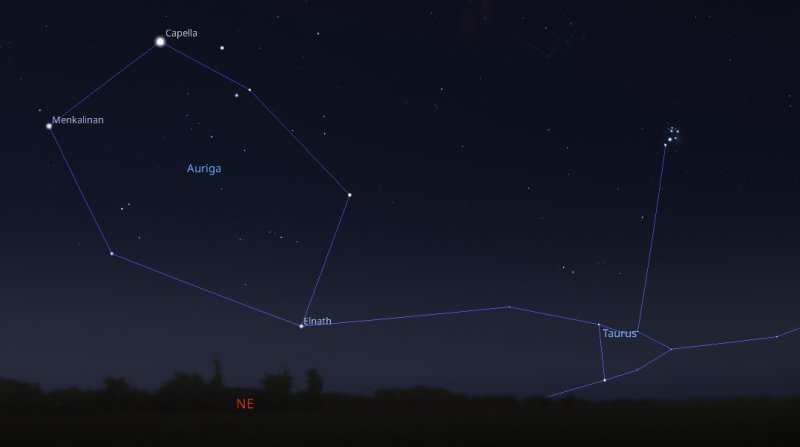 |
| |
|
There are a number of really good
opportunities to spot the International Space Station next week. Monday
10th at 1.21am, Tuesday 11th at 2.10am, Wednesday 12th at 1.22am, Thursday
13th at 12.34am and again on the Thursday at 2.11am. |
| |
|
In all these cases, the ISS will appear
towards the west and spend around 7 minutes passing almost directly overhead
before disappearing to the east. |
|
Monday 3rd to
Sunday 9th July 2023 |
| |
|
Lately I've been encouraging everyone to look
towards the west just as it's getting dark to see Venus and Mars. Well how
about giving our old friends, the gas giants Saturn and Jupiter, a chance?
Unfortunately this does mean either a late night or early morning though! |
| |
|
If you look towards the south east around 2am
on Friday 7th, Saturn will be sat just above an 81%-lit waning Gibbous
Moon. If at the same time you look further east, Jupiter will have just
risen above the horizon. |
| |
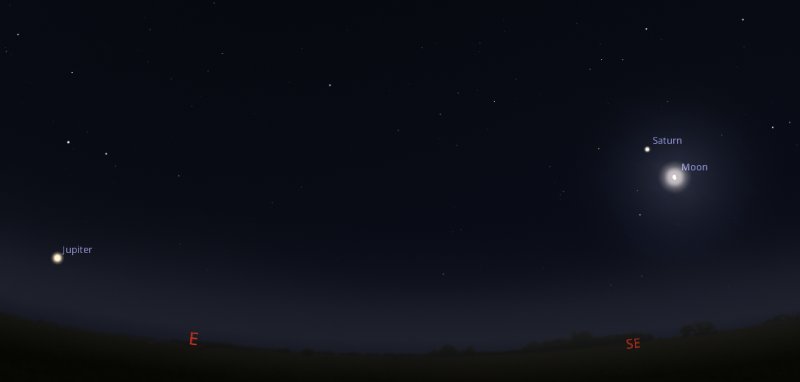 |
| |
|
If you prefer slightly more sociable hours,
there is still chance to catch a glimpse of a very bright Venus setting
towards the west just as it's getting dark. |
| |
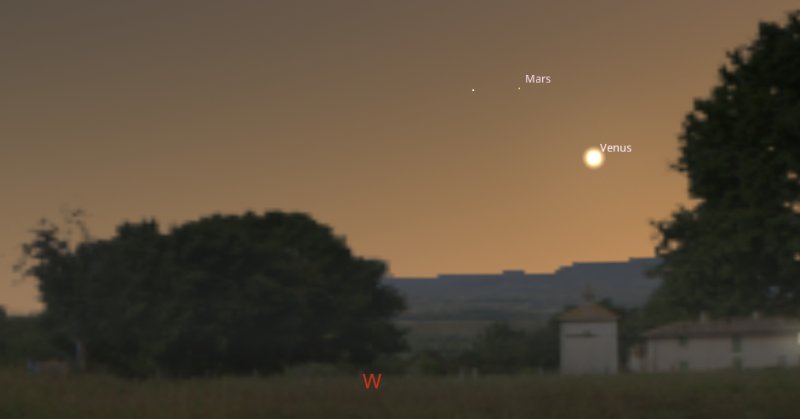 |
| |
|
Remember that the whole month of July is also
a good opportunity to observe Noctilucent clouds for up to a couple of hours
after sunset. These "night-shining" clouds are caused by sunlight
reflecting off layers of ice crystals in the upper atmosphere and are
notoriously difficult to predict. |
| |
|
There are three good opportunities to spot
the International Space Station next week. Monday 3rd at 3.45am, Wednesday
5th at 3.44am and Thursday 6th at 2.56am. In all three cases, the ISS will
appear towards the west and spend around 7 minutes passing almost directly
overhead before disappearing to the east. |
| |
|
If you have never observed the ISS before, it
appears to look like a star that is eerily moving quickly against the
background sky. The space station is actually travelling at an incredible
7.5km/s or approximately 17,500mph. It has to travel that fast to remain in
orbit and not fall back to Earth! |























